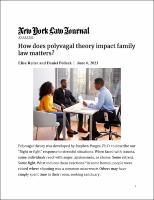Please use this identifier to cite or link to this item:
https://hdl.handle.net/20.500.12202/8953Full metadata record
| DC Field | Value | Language |
|---|---|---|
| dc.contributor.author | Reiter, Elisa | - |
| dc.contributor.author | Pollack, Daniel | - |
| dc.date.accessioned | 2023-06-06T21:43:01Z | - |
| dc.date.available | 2023-06-06T21:43:01Z | - |
| dc.date.issued | 2023-06-06 | - |
| dc.identifier.citation | Reiter, E., & Pollack, D. (2023, June 6). | en_US |
| dc.identifier.issn | 0028-7326 | - |
| dc.identifier.uri | https://www.researchgate.net/publication/371336500_How_does_polyvagal_theory_impact_family_law_matters | en_US |
| dc.identifier.uri | https://hdl.handle.net/20.500.12202/8953 | - |
| dc.description | Analysis | en_US |
| dc.description.abstract | Polyvagal theory was developed by Stephen Porges, Ph.D. to describe our “flight or fight” response to stressful situations. When faced with trauma, some individuals react with anger, anxiousness, or shame. Some retreat. Some fight. What induces these reactions? In some homes, people were raised where shouting was a common occurrence. Others may have simply spent time in their room, seeking sanctuary. | en_US |
| dc.language.iso | en_US | en_US |
| dc.publisher | ALM | en_US |
| dc.relation.ispartofseries | New York Law Journal;June 6, 2023 | - |
| dc.rights | Attribution-NonCommercial-NoDerivs 3.0 United States | * |
| dc.rights.uri | http://creativecommons.org/licenses/by-nc-nd/3.0/us/ | * |
| dc.subject | Polyvagal theory | en_US |
| dc.subject | "fight or flight" response | en_US |
| dc.subject | trauma | en_US |
| dc.subject | family law cases | en_US |
| dc.subject | self-regulation of emotions | en_US |
| dc.title | How does polyvagal theory impact family law matters? | en_US |
| dc.type | Article | en_US |
| dc.contributor.orcid | 0000-0001-7323-6928 | en_US |
| local.yu.facultypage | https://www.yu.edu/faculty/pages/pollack-daniel | en_US |
| Appears in Collections: | Wurzweiler School of Social Work: Faculty publications | |
Files in This Item:
| File | Description | Size | Format | |
|---|---|---|---|---|
| Reiter Pollack 6June2023 art NYLJ How does polyvagal theory impact family law matters.pdf | 308.76 kB | Adobe PDF |  View/Open |
This item is licensed under a Creative Commons License

